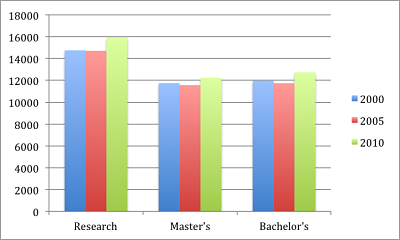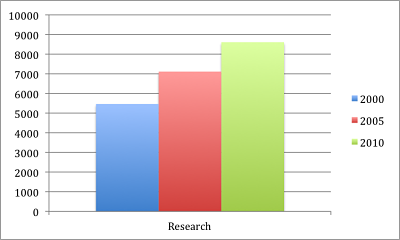In last week’s post, I described the major concepts in higher education finance: costs, price, and subsidy. Today, I describe the current trend data to provide additional context to the debate on higher education costs and price.

There are some great resources out there that report on these data each year. I highly recommend you check out the Delta Cost Project and the College Board which use the best information we have available to report on the trend of rising tuition.
Costs
Many criticize higher education’s escalating costs, but what they are truly frustrated by are the continual increases in tuition. Despite the claims, higher education has not dramatically increased costs. The graph below shows the costs to educate a student by the three primary types of public universities. The cost increases from 2000-2010 ranged between 4-8% accounting for inflation.
Price
If costs have only increased 4-8%, are we imagining the problem with tuition? Of course not! Let’s focus on public research universities for the sake of clarity and because they illustrate this trend most significantly. Public research universities receive most of the attention in the media also warranting a focus on them. As you can see in the graph below, there is quite a problem. Over the period from 2000-2010, tuition has grown at 57% far outpacing the growth of the costs to educate a student.
Subsidy
As I noted last week, the key concept in understanding the issue of costs and price in higher education is subsidy. Students do not pay for the full cost of their education. Government support mostly in the form of state appropriations and private gifts/endowments pay for the remaining costs. As you can see, the subsidy that helps pay for the costs to educate a student has declined and in 2010 was only 79% of 2000 levels.
What this means in real terms is that students are paying a greater percentage of the cost of their education. In 2000, students at public research universities paid 38.4% of the costs while students in 2010 paid 56.2%.
The bottom line is that tuition increases are largely a result of a shifting of the cost of paying for college. While universities can be their own worst enemy with public relations, fancy new student amenities (all those darn rock climbing walls), faculty and staff salaries (for those lazy faculty and underworked staff), and escalating costs are not to blame. If we want to slow the rate of tuition increases, there are only two options.
- Decrease the cost of education. This will impact the quality of the education offered. It is impossible to offer the same quality education at far lower costs. The same is true in any other industry. If you significantly cut the cost of production, the quality of your product will suffer.
- Change the priorities of our state legislators. Voters reward politicians that cut taxes, reduce spending, or increase money for K-12 education or prisons. There are little to no consequences for cutting higher education funding. As this data shows, these cuts are directly responsible for increasing tuition. In an economy that demands workers have some form of education, we must do better.





